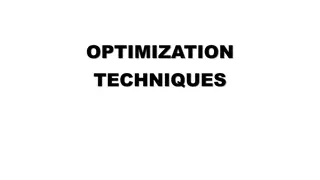System Setup and Performance Optimization Guide
Discover essential steps for maximizing system performance in Entrinsik Informer 5 through health checks, common troubleshooting methods, data governance principles, transparency, system setup for Windows and Docker/Linux servers, and fine-tuning for Elasticsearch.
Download Presentation

Please find below an Image/Link to download the presentation.
The content on the website is provided AS IS for your information and personal use only. It may not be sold, licensed, or shared on other websites without obtaining consent from the author.If you encounter any issues during the download, it is possible that the publisher has removed the file from their server.
You are allowed to download the files provided on this website for personal or commercial use, subject to the condition that they are used lawfully. All files are the property of their respective owners.
The content on the website is provided AS IS for your information and personal use only. It may not be sold, licensed, or shared on other websites without obtaining consent from the author.
E N D
Presentation Transcript
Health Check and Health Check and Common Troubleshooting Common Troubleshooting How to maximize system performance within Informer 5 Kevin Houk, Implementation Specialist, Entrinsik
Data Governance Data Governance Tenets Tenets Data Integrity Data Level Security Content Level Security Functional Level Security Transparency Traceability Data Quality Controlled Reuse Governed Blended Data
Transparency & Traceability Transparency & Traceability System Setup Auditing Logging System Health Check
System Setup System Setup Windows server specs minimum o Windows Server 2016, 2019, 2022 (all updates) o No IIS or other applications on server o Quad-core CPUs o 16GB RAM (32GB recommended) o 80GB+ disk space o Client browser: Anything but Internet Explorer! o https://informer5.zendesk.com/hc/en-us/articles/115004498926-Hardware-and-Software- Requirements
System Setup System Setup Docker / Linux server specs Docker / Linux server specs o Hardware specs same as Windows Server o Supported Linux Distributions o Ubuntu, Debian, Fedora (must be able to support Docker) o Docker o Docker Community Edition (free! use me!) o Docker Enterprise Edition (not free but if you have it, use it) o Docker Compose o https://informer5.zendesk.com/hc/en-us/articles/115004498926-Hardware-and-Software- Requirements#Linux_Requirements
System Setup System Setup Windows Tuning Windows Tuning - - Elasticsearch Elasticsearch o Careful when tweaking with just minimum hardware specs o Elasticsearch o Check Java memory usage in Task Manager o 4 GB of memory typical if server hardware meets minimum requirements o Can be increased check with Entrinsik Support o Consider increasing ES memory if using a lot of large Datasets, Visuals, Dashboards and have a lot of users Elasticsearch 8
System Setup System Setup Windows Tuning Windows Tuning - - Elasticsearch (cont.) Elasticsearch (cont.) C:\Entrinsik\Informer5\elasticsearch\elasticsearch- 8.2.2\bin\elasticsearch elasticsearch- -service.bat manager service.bat manager elasticsearch8 elasticsearch8 Initial and Maximum Memory Pool MUST MUST be the same Leave Thread stack size at 1024 KB Restart ES Service if changes made
System Setup System Setup Windows Tuning Windows Tuning - - Load Balancer Load Balancer o Careful when tweaking with just minimum hardware specs o The Load Balancer sets up separate processes for the different core components of Informer 5 Queries - handles all database query executions API - the main web server component, handling all UI requests Scheduler - handles all Job executions Reverse Proxy - acts as a proxy server and is the main entry point for all requests o Spreading the load across different threads can improve performance of the Informer application when handling larger volumes of requests and/or data o C:\Entrinsik\Informer5\service.config.json
System Setup System Setup Windows Tuning Windows Tuning - - Load Balancer (cont.) Load Balancer (cont.) Default Two instances each using 1GB memory
System Setup System Setup Windows Tuning Windows Tuning - - Load Balancer (cont.) Load Balancer (cont.) Enhanced node_args - Query thread using 2GB instead of 1GB. Two instances each using 2GB gives 4GB to the Query thread max_memmory_restart - prevents a thread from locking up if memory exceeds 2GB, this setting will cause the thread to automatically restart if it hits 2.5 GB
System Setup System Setup Windows Tuning Windows Tuning - - Load Balancer (cont.) Load Balancer (cont.)
System Setup System Setup Windows Tuning Windows Tuning - - Load Balancer (cont.) Load Balancer (cont.)
System Setup System Setup Windows Tuning Windows Tuning - - Load Balancer (cont.) Load Balancer (cont.) C:\> pm2 ls - Use this command to see useful data about your worker threads - Uptime and Status has any thread crashed and/or restarted - How much memory and CPU is currently being used? - Snapshot in time
System Setup System Setup Windows Tuning Windows Tuning - - Redis Redis Redis is a temporary data storage area for certain processes in Informer. Imports. Exports. Query Samples, Flow Steps, etc. C:\Program Files\Redis\redis.windows.conf Disable Snapshots saving to disk. Saves a lot of disk I/O
System Setup System Setup Windows Tuning Windows Tuning - - Redis Redis Disable Redis Snapshot Persistence: C:\Program Files\Redis\redis-cli.exe # info memory # flushall
Transparency and Traceability Transparency and Traceability - - Auditing Auditing System Audit Data Governance Which queries are consuming the most time? Which users are creating them? Can the queries be made more efficient? What content isn t being used? Are there 10 Jobs queued to run at the same time? Clear where data is coming from Clear on who is doing what to relative content Verify only authorized people able to access what they re supposed to Eliminate lack of confidence in data backing important business decisions
Auditing Auditing System Audit System Audit The new way to monitor system resources to keep Informer running efficiently. Who is using Informer? And how? How fast are queries running? What content isn t being used? See how Users are using Informer, optimize slow-running queries across the system and clean out unused content from Informer.
Auditing Auditing System Audit (Administration > Settings > Audit)
Auditing Auditing Audit Queries Records all Queries executed against Datasources Tracked data includes the Datasource, User, Query time and status Allows Administrators to track what parts of Informer are being used the most often and when and who is using which parts
Auditing Auditing Audit Requests Records all API Requests made against Informer. Tracked data includes the API route, User, Time and Response Code. Useful to Admins who want to keep Informer running at peak performance
Transparency & Traceability Transparency & Traceability - - Logging Logging Request Logs: Contains information about requests made of Informer, such as the time it took for a request to be processed, the type of request and additional information about a specific log message. Console Logs: Contains a live feed to API calls that Informer is making as they are made.
Logging Logging Request Logs and Console Logs Unless troubleshooting something specific, do not set Log Level to above `Info` Request Logs can be filtered by Time, Tags, Result and other parameters, while Console Logs cannot
Logging Logging Log Areas System application logic and events Elasticsearch queries Datasource queries
Logging Logging Log Levels None No logs collected for area Error Captures only events that prevents an action from completing Warn Captures logs anytime something unexpected happens that Informer can handle
Logging Logging Log Levels Info Lowest level of logs that also include successful requests and logs. Also contains all warnings and errors. Debug 2nd highest volume of logging. Contains all debugging info. Trace Highest level of logging. Captures all the logs included in Informer giving highest detail of what's happening all of the time.
Logging Logging Log Filters
Logging Logging Browser Logging Settings
Transparency & Traceability Transparency & Traceability System Health System Health Allows users to see information on Datasets and Elasticsearch indices Can help Admins understand what is happening in Elasticsearch from within Informer
System Health System Health Unindexed Datasets A Dataset that doesn t have any data because it s not been refreshed, or the data has been cleared. As well, the Dataset could be missing an index if it s deleted or corrupted at the Elasticsearch level. Can drilldown to open a window that shows specifics
System Health System Health Unindexed Datasets
System Health System Health Running Elasticsearch Searches & Scrolls Searches Searches: Returns hits that match the Query definition in the query s request Scrolls Scrolls: Retrieves a stream of search results matching the query Note: High numbers can result in performance issues
System Health System Health Running Elasticsearch Searches & Scrolls Running Elasticsearch Searches & Scrolls
System Health System Health Orphaned & Expired Indices Indices (results) that don t have an associated Dataset or Report. Their time on the system has expired but are still hanging around. System delivered Auto Cleanup job should be running every night
System Health System Health Orphaned & Expired Indices
System Health System Health Query Benchmarking Helps identify two possible bottlenecks in a query s performance Indexing: evaluating the connection speed between Informer and Elasticsearch Flow Steps: are there slowdowns because of a particular Flow Step?
System Health System Health
Windows Tuning Windows Tuning Job Setup Job Setup Spread out Jobs give them room to run and complete Lower Job History Size. The larger this is, the response time in the Job area will be reduced.























